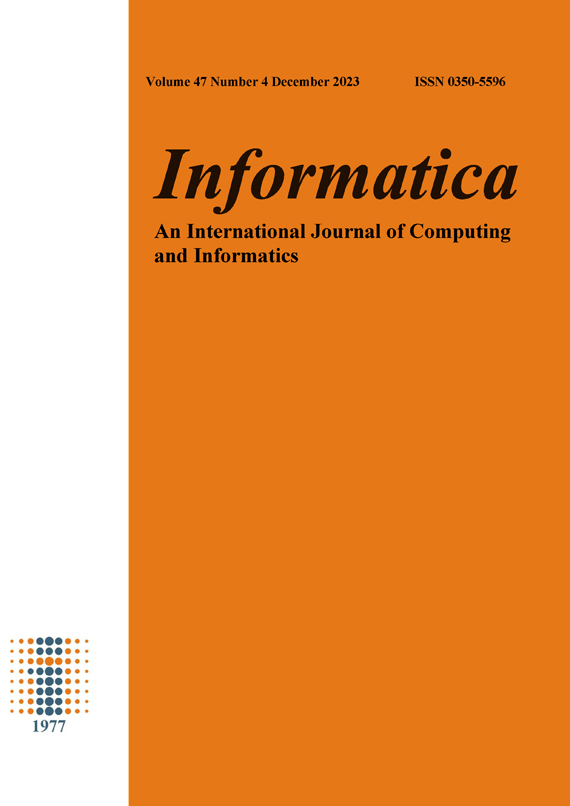Hybrid Compression Algorithm for Energy Efficient Image Transmission in Wireless Sensor Networks Using SVD-RLE in Voluminous Data Applications
DOI:
https://doi.org/10.31449/inf.v47i4.5041Abstract
WSNs are used in different applications and the enormous volume of data they collect and broadcast across the network overburdens the sensor nodes and this issue can be mitigated by compressing the data before transmitting it over the network. Singular Value Decomposition, a state-of-the-art non-transform based compression method, primarily for dimensionality reduction in any type of data, is utilized in this study. In this, the difference between the adjacent pixel values is computed as a preprocessing step, and then compressed, which is represented by three singular matrices: two orthonormal matrices (X, Y), and one diagonal matrix called rank matrix. The resultant data is then applied through a Run Length Encoding step and transmitted. By compressing the image with different thresholds, the rank value is altered and since the pixel differences are only encoded and in terms of a relatively small number of bits, the outcome is represented with a compression ratio of approximately 12% and also the reconstructed image at the receiver exhibits good Peak Signal to Noise Ratio (PSNR). The use of this strategy in WSNs is also justified by analyzing the amount of energy savings and the nodes' energy usage using standard energy models and the percentage of energy saving varies from 25% to 53 % with the decrease in the rank values respectively.
References
Hongran Li et al., “Singular vector sparse reconstruction for image compression”, Computers and Electrical Engineering, Vol. 91 (2021). https://doi.org/10.1016/j.compeleceng.2021.107069.
Khadeejah James Audu, “Application of singular value decomposition for compressing images”, Gadau Journal of Pure and Allied Sciences, 1(2): 82-94 (2022). https://doi.org/10.54117/gjpas.v1i2.21
Ranjeet Kumar et al., “An efficient technique for image compression and quality retrieval using matrix completion”, Journal of King Saud University – Computer and Information Sciences, Vol. 34 (2022). https://doi.org/10.1016/j.jksuci.2019.08.002
B. Mtengi et al, “Data compression algorithms for wireless sensor networks: A review and comparison”, IEEE Access, Vol. 9 (2021). DOI: 10.1109/ACCESS.2021.3116311
Hung-Yi Chen et al., “Improved efficiency on adaptive arithmetic coding for data compression using range-adjusting scheme, increasingly adjusting step, and mutual-learning scheme”, IEEE Transactions on Circuits and Systems for Video Technology (2017). DOI: 10.1109/TCSVT.2017.2749449
Stacey L. Ernstberger et al., “Singular value decomposition: applications to image processing”, Citations Journal of Undergraduate Research, Vol. 17 (2020).
Mario Siller et al., “Wireless sensor networks formation: approaches and techniques”, Journal of Sensors, Vol. 2016. https://doi.org/10.1155/2016/2081902
Azniza Abd Aziz et al., “Error-control truncated SVD technique for in-network data compression in wireless sensor networks”, IEEE Access (2021). DOI: 10.1109/ACCESS.2021.3051978
Helio Pedrini et al., “Adaptive lossy image compression based on singular value decomposition”, Journal of Signal and Inf. Processing, Vol. 10 (2019). DOI: 10.4236/jsip.2019.103005
Chong Han et al., “An image compression scheme in wireless multimedia sensor networks based on NMF”, Information, MDPI (2017). DOI: 10.3390/info8010026
M. S. Chavan et al, “Comparative analysis of singular value decomposition (SVD) and wavelet difference reduction (WDR) based image compression”, International Journal of Engr. Research and Technology, Vol. 10, No. 1 (2017).
Awwal Mohammed Rufai et al. “Lossy image compression using singular value decomposition and wavelet difference reduction”, Digital Signal Processing, Vol. 24 (2013). DOI: 10.1016/j.dsp.2013.09.008
Rahebi J, “Vector quantization using whale optimization algorithm for digital image compression”, Multimedia Tools and Applications, Vol. 81 (2022). https://doi.org/10.1007/s11042-022-11952-x
Zermi, N et al., “A lossless DWT-SVD domain watermarking for medical information security”, Multimedia Tools and Applications, Vol. 80 (2021). https://doi.org/10.1007/s11042-021-10712-7
Ali Al-Fayadh et al., “An efficient singular value decomposition based classified vector quantization using discrete wavelet transform and its application to image compression”, International Journal of Innovative Research in Science & Engineering (2016).
Fuad Bajaber, et al., “Adaptive decentralised re-clustering protocol for wireless sensor networks”, Journal of Computer and System Sciences, Vol. 77, No. 2, (2011). https://doi.org/10.1016/j.jcss.2010.01.007
G. Sudha, C. Tharini, "Analysis of wavelets on discrete wavelet transform for image compression and transmission in wireless sensor networks", 2022 International Conference on Communication, Computing and Internet of Things (IC3IoT) (2022). DOI: 10.1109/IC3IOT53935.2022.9767977
V. K. Subhashree et al., "Modified LEACH: A qos-aware clustering algorithm for wireless sensor networks," 2014 International Conference on Communication and Network Technologies (2014). DOI: 10.1109/CNT.2014.7062737
Downloads
Published
Issue
Section
License
I assign to Informatica, An International Journal of Computing and Informatics ("Journal") the copyright in the manuscript identified above and any additional material (figures, tables, illustrations, software or other information intended for publication) submitted as part of or as a supplement to the manuscript ("Paper") in all forms and media throughout the world, in all languages, for the full term of copyright, effective when and if the article is accepted for publication. This transfer includes the right to reproduce and/or to distribute the Paper to other journals or digital libraries in electronic and online forms and systems.
I understand that I retain the rights to use the pre-prints, off-prints, accepted manuscript and published journal Paper for personal use, scholarly purposes and internal institutional use.
In certain cases, I can ask for retaining the publishing rights of the Paper. The Journal can permit or deny the request for publishing rights, to which I fully agree.
I declare that the submitted Paper is original, has been written by the stated authors and has not been published elsewhere nor is currently being considered for publication by any other journal and will not be submitted for such review while under review by this Journal. The Paper contains no material that violates proprietary rights of any other person or entity. I have obtained written permission from copyright owners for any excerpts from copyrighted works that are included and have credited the sources in my article. I have informed the co-author(s) of the terms of this publishing agreement.
Copyright © Slovenian Society Informatika








